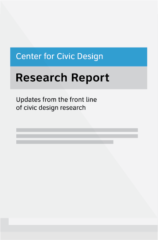The impact of plain language on voter signature forms
When voting by mail, voters sign a legal statement declaring that they are qualified to vote and have followed the rules for this method of voting. The statements are often hard to understand.
We looked at statements on ballot envelopes in 26 states. We wanted to know how difficult the statements are to read, and what it would take to fix the problem so that more voters understand what they are signing and successfully cast their mail ballot.

Making ballot envelopes clear and understandable: The impact of plain language on voter signature forms
Download reportKey findings
Good design and plain language reduce ballot rejections
When the text on ballot envelopes is written with voters’ needs in mind, voters are able to understand and use them better. And when voters can understand and use ballot envelopes for their intended purpose, we see fewer rejected ballots.
We propose 2 major considerations when designing ballot envelopes:
- Use good design practices that guide the voter rather than confuse them
- Use clear, concise language so that voters can understand and use their ballot envelopes effectively
In addition, we recommend doing usability testing with real voters and using free online resources like Hemingway Editor to support the design and language strategies that we outline in this report.
Putting the research to work
There are many ways to improve ballot envelope forms
Strategies for immediate change include:
Use layout for clarity
- Add bullets to separate clauses in the voter statement
- Use a conventional form field layout instead of interspersing blanks in a paragraph
- Highlight the signature area
Make the text easier to read
- Take advantage of any flexibility in the law to minimize the number of complex words and overall length of the text
- Write instructions following plain language best practices
- Include checklists for packing the envelope accurately
Strategies for longer-term impact include:
Create best-practice templates
- Demonstrate envelope and voter statement text and layout that meets state law while improving the readability and legibility of the envelopes
- Encourage consistency among local jurisdictions to make it easier to conduct statewide voter education campaigns
Update state policies and regulation
- Allow for text and layout to be edited for clarity and plain language as long as it substantially meets the goals of the current policy
- Update the election code to simplify the language of the statements for plain language, readability, and legibility
- Rethink policies and requirements to be sure they meet goals for election integrity while still making it easier for voters to have their ballots counted.
Get wide input on any changes from all stakeholders
- Include election officials, community advocates, and election experts in creating updated materials
- Test the templates and sample designs for usability with a wide range of voters, including new and infrequent voters, low English proficiency, and voters with disabilities.
About the research
This research was conducted by Sean Isamu Johnson and Whitney Quesenbery.
We looked at statements on ballot envelopes in 26 states. We conducted content analysis to identify the purpose of each voter statement.
Then we conducted a readability analysis. The central question of the readability analysis was whether the voter statement—including all the text of the legal statement—is easy enough for voters to read that they are likely to understand the statement they sign.
Related research
For actionable tips from this research, you can check out our article 3 strategies to improve vote-by-mail signature forms.
Visit our page on vote by mail to find more resources about designing envelopes, instructions and other materials that voters interact with during their vote by mail process.

